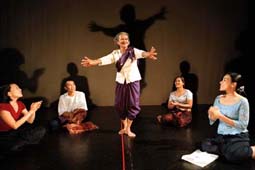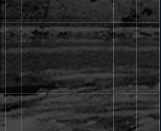
Photo
Copyright @ Mara Lavitt |
"In
asking them to tell these stories, I would become their judge,"
said Keng Seng. "Thong Kim Ann would ask me if I thought she
was guilty of killing her husband. Because I had asked them to tell
the stories, they saw me as some kind of authority figure. I had
conceived this project and got them together. I had to be responsible
in a way that directors don’t have to be." It must be
added that he was called upon to adjudicate where there has been
no legal process of adjudication, no public closure on guilt. Nor
is he a therapist in a culture where there have been no medical
avenues for individual healing. Personal reaction to the atrocities
has often been shame, which becomes a way of dealing with the past.
Other questions arose after the project was shown to audiences for
the first time in New Haven: "There were new tears. Em Theay
herself is much more meditative. Now seventy, she seems to feel
that this is a part of her history. The younger ones feel very strongly
that their lives have been set back, destroyed, robbed. I spoke
to them afterwards--and this is one of the tensions of being a director
in these very unusual circumstances. With actors, I would have said,
`Okay guys, you’re crying too much. You’re alienating
the audience. You have to control yourselves, because control leads
to power.’ But I can’t tell these people that. I can’t
tell them how I think their story should be told. Last night, I
told them that I would like the audience to believe that they are
brave people, not overwhelmingly victims of the past.
"There is a very difficult catch-22 in a country like Cambodia
which has so much dependency on the foreign donations that come
through aid organizations. There is a victim mentality. They have
to play that role in order to get some of the dole-outs. This is
prevalent in some areas of the country, but Cambodians are very
resilient, very brave people. So, I said to them last night that
they are moving into a time when their tears need to be shed for
other reasons. They must no longer be just tears of sorrow. What
happens after sorrow?" The piece is entitled The Continuum:
Beyond the Killing Fields.
|
|


